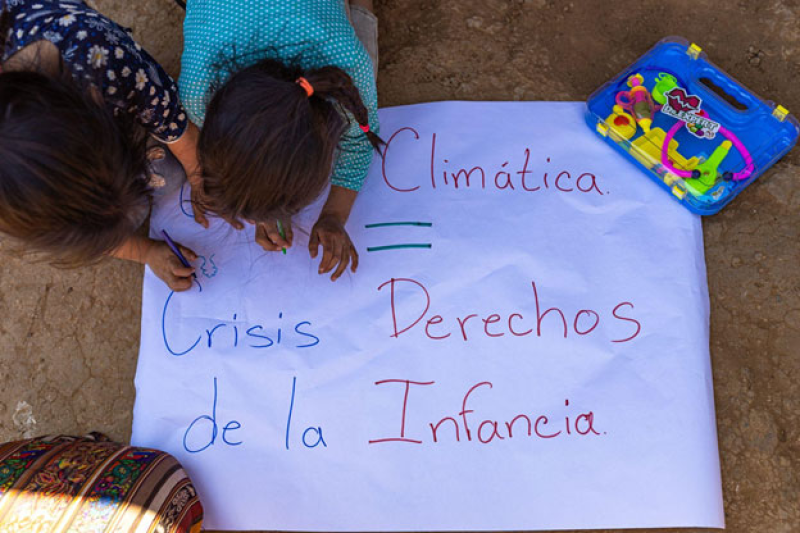- Bomb blast kills 15 near political rally in Pakistan |
- Corruption Persists Despite Uprising, TI Chairman Warns |
- Gaza Attacks Intensify as Disabled, Hungry Civilians Suffer |
- Stock indices edge up in first hour at DSE, CSE |
- World Cup ticket prices to start at $60, may rise to $6,730 |
Climate Change Worsens Child Poverty in Latin America

A family prepares a banner to protest the effects of climate change on children outside their house in the village of Patzité, Quiché, Guatemala.
2025 has been marked by a significant escalation of the climate crisis and its effects on vulnerable populations, as the World Meteorological Organization (WMO) warns that average global temperatures could exceed the 1.5°C threshold within the next five years. In Latin America and the Caribbean, rising temperatures and emissions continue to strain access to essential services and deepen poverty, particularly among children.
“Children and adolescents bear the greatest burden of climate change,” said Roberto Benes, Regional Director for Latin America and the Caribbean at the United Nations Children’s Fund (UNICEF). “Not only are their developing bodies more vulnerable to extreme phenomena such as cyclones or heatwaves, but these events also disrupt their families’ livelihoods and education. If children and young people do not have the resources to meet their basic needs and develop their potential, and if adequate social protection systems are not in place, the region’s inequalities will only be perpetuated.”
On 28 August, the Economic Commission for Latin America and the Caribbean (ECLAC) and UNICEF published a joint report, The Impact of Climate Change on Child and Youth Poverty in Latin America, detailing the effects of climate change on youth poverty and current government and humanitarian initiatives aimed at climate adaptation and loss mitigation.
According to the report, poverty rates in Latin America have risen sharply since the COVID-19 pandemic, pushing an additional 22 million people into poverty. Roughly 94 million children and adolescents are living in poverty, making up 52 percent of the region’s poor population. Despite youth accounting for only 39 percent of the total population, around 40 percent of children under the age of 15 live in poverty.
The frequency of extreme weather events in Latin America has skyrocketed in recent years, reaching nearly 30 per year in the early 2020s. In the Caribbean, some countries are already experiencing monthly temperature increases exceeding the 1.5°C threshold, while countries such as Argentina and Chile face volatile precipitation patterns that increase flooding, particularly in low-lying coastal communities.
According to UNICEF’s Child Climate Risk Index, roughly 55 million children in Latin America and the Caribbean face water shortages, 60 million experience cyclones, and 45 million are exposed to extreme heat. Floods and landslides caused by heavy rains have damaged critical infrastructure such as schools, healthcare centers, and water, sanitation, and hygiene (WASH) facilities. Rising temperatures have also contributed to a rise in waterborne and vector-borne diseases, including diarrhea, malaria, Zika, and dengue.
Agriculture and food production have been hindered by persistent droughts, particularly in northeastern Brazil, areas in the Southern Cone, and the Central American dry corridor. Poor children and adolescents in these regions face extended periods of nutritional deprivation, increasing the risk of malnutrition. Between 570,000 and over 1 million children under 5 could suffer from stunted growth by 2030 due to climate change.
Estimated economic losses from natural disasters have increased nearly tenfold since the 1960s. “These impacts divert resources towards damage repair and adaptation instead of investing in infrastructure, education, or innovation. This creates an opportunity cost by limiting potential growth and perpetuates development gaps, hindering the reduction of inequalities in Latin America,” the report said.
Current climate adaptation policies and funding fail to adequately prioritize children’s needs, with essential services such as health, nutrition, education, water, and sanitation limited, jeopardizing cognitive and physical development. By 2030, at least 5.9 million additional children, adolescents, and youth could be pushed into poverty—a figure that could rise to nearly 17.9 million if funding and humanitarian action remain insufficient.
Although children and adolescents are the most climate-vulnerable populations, climate financing directed toward youth accounts for just 3.4 percent of the region’s multilateral climate funding, totaling roughly USD 743 million. These funds primarily cover education projects and do not address urgent needs in other basic sectors, such as healthcare. Moreover, child-sensitive climate funds reach children in only six countries: Brazil, Cuba, Guatemala, Haiti, Trinidad and Tobago, and Uruguay.
The report also warns that climate change risks worsening existing wealth disparities and gender inequality. Latin America and the Caribbean—the “most unequal region in the world”—face the likelihood of poorer families experiencing higher rates of poverty, hindered recovery, and greater challenges in adapting to natural disasters. Women and girls are disproportionately affected, facing higher unemployment, difficulty reentering the workforce, asset losses, and increased school dropout rates.
“Without investment in resilient services for children, and without sustained political will from countries and other sectors to reduce greenhouse gas emissions, the children and youth of 2030 will continue to be deprived of their rights,” said UNICEF climate advisor Reis López. “This will only perpetuate inequality in one of the most unequal regions of the world.”

